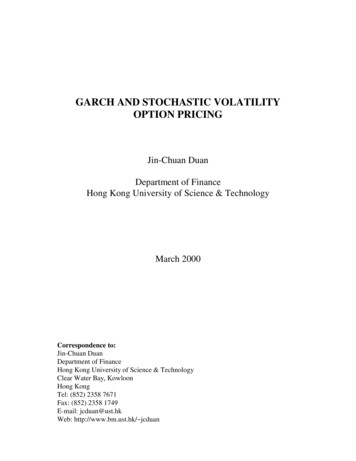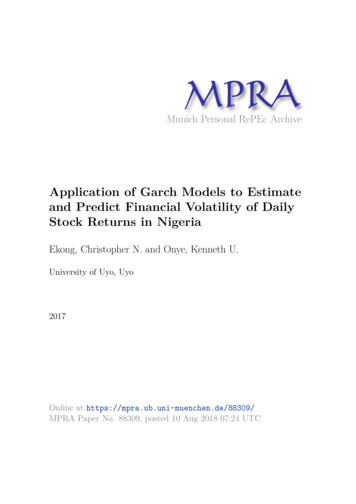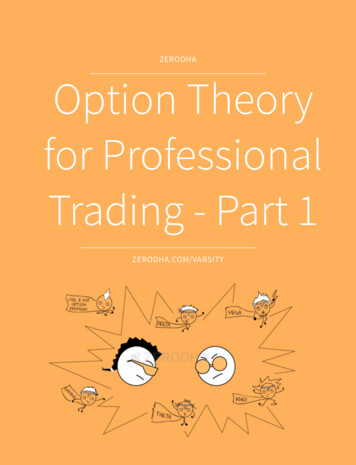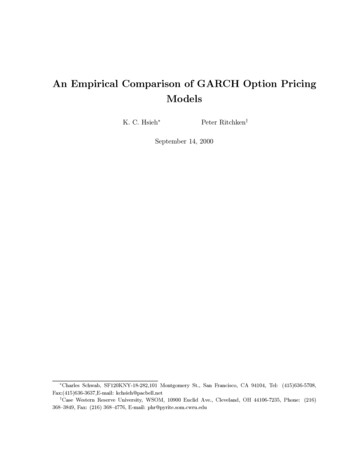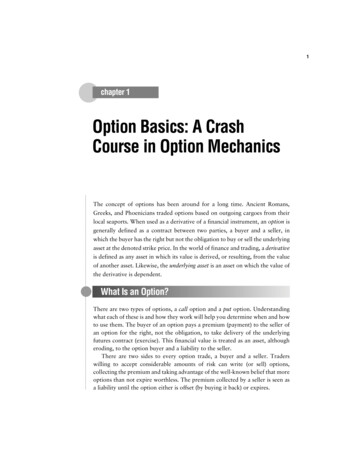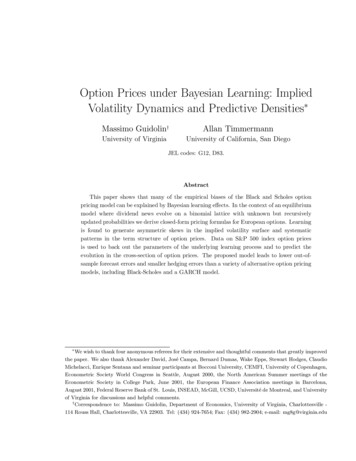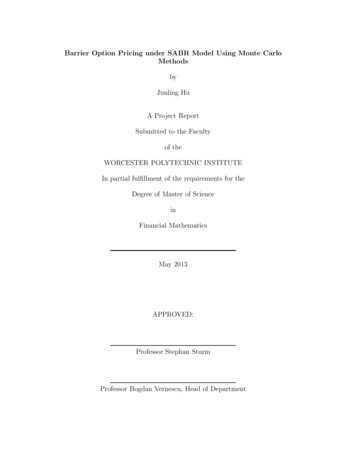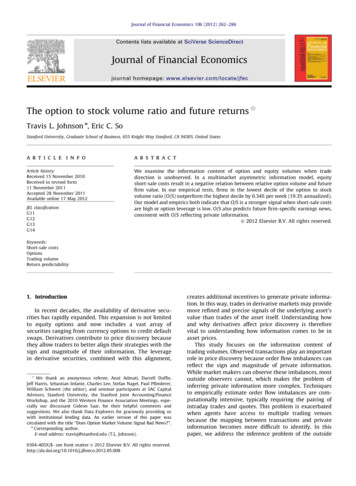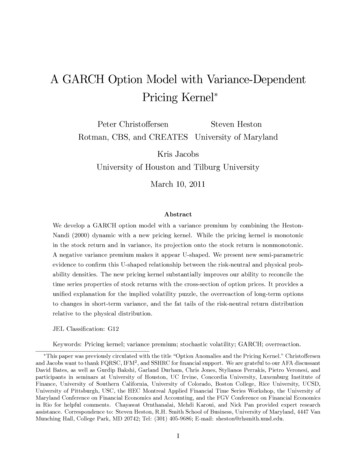
Transcription
A GARCH Option Model with Variance-DependentPricing KernelPeter Christo ersenSteven HestonRotman, CBS, and CREATES University of MarylandKris JacobsUniversity of Houston and Tilburg UniversityMarch 10, 2011AbstractWe develop a GARCH option model with a variance premium by combining the HestonNandi (2000) dynamic with a new pricing kernel. While the pricing kernel is monotonicin the stock return and in variance, its projection onto the stock return is nonmonotonic.A negative variance premium makes it appear U-shaped. We present new semi-parametricevidence to con rm this U-shaped relationship between the risk-neutral and physical probability densities. The new pricing kernel substantially improves our ability to reconcile thetime series properties of stock returns with the cross-section of option prices. It provides auni ed explanation for the implied volatility puzzle, the overreaction of long-term optionsto changes in short-term variance, and the fat tails of the risk-neutral return distributionrelative to the physical distribution.JEL Classi cation: G12Keywords: Pricing kernel; variance premium; stochastic volatility; GARCH; overreaction.This paper was previously circulated with the title “Option Anomalies and the Pricing Kernel.”Christo ersenand Jacobs want to thank FQRSC, IFM2 , and SSHRC for nancial support. We are grateful to our AFA discussantDavid Bates, as well as Gurdip Bakshi, Garland Durham, Chris Jones, Stylianos Perrakis, Pietro Veronesi, andparticipants in seminars at University of Houston, UC Irvine, Concordia University, Luxemburg Institute ofFinance, University of Southern California, University of Colorado, Boston College, Rice University, UCSD,University of Pittsburgh, USC, the HEC Montreal Applied Financial Time Series Workshop, the University ofMaryland Conference on Financial Economics and Accounting, and the FGV Conference on Financial Economicsin Rio for helpful comments. Chayawat Ornthanalai, Mehdi Karoui, and Nick Pan provided expert researchassistance. Correspondence to: Steven Heston, R.H. Smith School of Business, University of Maryland, 4447 VanMunching Hall, College Park, MD 20742; Tel: (301) 405-9686; E-mail: sheston@rhsmith.umd.edu.1
1IntroductionContinuous-time models have become the workhorse of modern option pricing theory. Theytypically o er closed-form solutions for European option values, and have the ‡exibility of incorporating stochastic volatility (SV) with leverage e ects and various types of risk premia (Heston,1993, Bakshi, Cao and Chen, 1997). Stochastic jumps and jump risk premia can capture additional variation in the conditional distribution of returns (Broadie, Chernov and Johannes, 2007).However, the resulting models can be cumbersome to estimate with time-series data, due to theneed to lter the unobserved stochastic volatility and jump intensity.In contrast, discrete-time GARCH models (Engle, 1982, Bollerslev, 1986) dominate the timeseries literature. They are easy to lter and estimate with multiple factors (Engle and Lee,1999), long memory (Bollerslev and Mikkelsen, 1996), and non-Gaussian innovations (Bollerslev,1987, and Nelson, 1991). The GARCH framework o ers four advantages for the purpose ofempirical option valuation. First, it may be considered an accurate numerical approximation toa continuous-time model (Nelson, 1992 and 1996), or an internally consistent framework thatmakes exact predictions at the frequency of available data, avoiding any discretization bias.1Second, its predictions are exactly compatible with the lter used to extract the variance. Third,the volatility prediction performance of GARCH is often found to be very similar to that of SVmodels (Fleming and Kirby, 2003). Fourth, estimation is computationally fast.Several valuation results are available for European option pricing with a GARCH dynamic,2but all existing models are characterized by the same limitation. The ltering problem in thesemodels is straightforward because the distribution of one-period returns has a known conditionalvariance. This does not severely restrict variance modeling, but it has implications for optionpricing. Because the models do not contain an independent adjustment for variance risk, theydo not o er much ‡exibility in the modeling of variance risk premia.Instead, the speci cation of variance premia in GARCH models has to be carefully integratedwith the speci cation of the equity risk premium, which requires an explicit speci cation ofthe pricing kernel. Existing models use the risk-neutral valuation relationship of Rubinstein(1976) and Brennan (1979). This produces the Black-Scholes (1973) formula for one-periodoptions, and limits the models’ability to explain longer-term option prices. This paper insteadspeci es a variance-dependent pricing kernel and combines it with the Heston-Nandi (2000)dynamic. The variance-dependent pricing kernel implies a quadratic pricing kernel when viewed1See Lamoureux and Paseka (2009) on the role of discretization bias in implementations of the Heston (1993)model.2See Duan (1995) and Heston and Nandi (2000) for the case of conditionally normal innovations, and BaroneAdesi, Engle and Mancini (2008) and Christo ersen, Heston, and Jacobs (2006) for applications with non-normalinnovations. See Duan and Simonato (2001) and Ritchken and Trevor (1999) for numerical methods for Americanoption valuation.2
as a function of the stock return. This generates an additional risk premium associated withvariance, but uncorrelated with equity risk, making the model a discrete-time analog of Heston’s(1993) stochastic volatility model. Using the new pricing kernel, we obtain closed-form solutionsfor option values based on a risk-neutral variance process that has the same functional form asthe physical variance process, but that di ers from the physical variance process along severaldimensions. The model nests and substantially generalizes the Heston-Nandi (2000) framework.We demonstrate that the new model can address some existing option pricing puzzles. Mostimportantly, it not only captures the fat tails of the option-implied return distribution, commonlyreferred to as the implied volatility smile, it also explains why these tails are fatter than those ofthe return-based distribution. Bates (1996a) emphasized the importance of this question: “thecentral empirical issue in option research is whether the distributions implicit in option pricesare consistent with the time series properties of the underlying asset prices.” While subsequentstudies have addressed this issue, it has proved di cult to reconcile the empirical distributionsof spot returns with the risk-neutral distributions underlying option prices.The new model also addresses several other empirical puzzles that have emerged from theoptions literature. A well-known puzzle is that volatilities implied by option prices tend toexceed realized volatility. This puzzle is well-known and understood in terms of a negativeprice of variance risk. Another variance puzzle is the expectations puzzle: implied variancesdo not provide an unbiased forecast of subsequent variance.3 Furthermore, Stein (1989) andPoteshman (2001) show that long-term implied variance overreacts to changes in short-termvariance. This puzzle involves movements in the term structure of implied volatility and isrelated to the expectations puzzle. Taken together, these anomalies indicate misspeci cation inthe dynamic relationship between option values and the time series of spot returns. Becausethey are usually not discussed in the context of a parametric framework, the literature has notexplicitly linked them to Bates’statement, but they are intimately related. In addition to theselongitudinal expectations puzzles, available models have di culty explaining the cross-section ofoption prices, particularly the prices of out-of-the-money options. It has been recognized thatthis evidences a “pricing kernel puzzle,” in the sense that available pricing kernels may not begeneral enough to explain option data.4Together the puzzles pose a collective challenge to option models. We attempt to provide auni ed explanation for these puzzles by formulating a more general pricing kernel. Our analyticalresults indicate that the suggested pricing kernel is able to qualitatively account for the puzzles.We also want to demonstrate that the new pricing kernel can quantitatively explain option prices3See Day and Lewis (1992), Canina and Figlewski (1993), Lamoureux and Lastrapes (1993), Jorion (1995),Fleming (1998), Blair, Poon and Taylor (2001), and Chernov (2007) among others.4See for instance Brown and Jackwerth (2001), Bates (2008), and Bakshi, Madan, and Panayotov (2010).3
and resolve the discrepancy between option prices and the time series of underlying index returnspointed out by Bates (1996a). So we implement an empirical analysis using an objective functionwith a return component and an option component. The discrete-time GARCH structure of themodel facilitates ltering, and its numerical e ciency makes it possible to maximize this objectivefunction in a large-scale empirical exercise.The empirical results are quite striking. Imposing the new variance dependent pricing kerneldramatically improves model t compared to a traditional pricing kernel with equity risk only.The new model reduces valuation biases across strike price and maturity, and the resulting tis reasonably close to that of an unrestricted ad-hoc model. The new pricing kernel adequatelycaptures the premium of risk-neutral variance relative to physical variance, as well as the higherrisk-neutral volatility of variance. While the estimated persistence of risk-neutral variance islarger than the persistence of physical variance, the di erence is smaller than in the ad-hocmodel, indicating that the new pricing kernel qualitatively but not quantitatively captures thisstylized fact. Presumably this is due to the fact that capturing variance persistence is not heavilyweighted in the likelihood.A number of existing studies on option valuation and general equilibrium modeling are relatedto our ndings. Several studies have argued that modi cations to standard preferences areneeded to explain option data.5 Ait-Sahalia and Lo (2000) and Jackwerth (2000) have notedthe surprising implications of option prices for risk-aversion, and Shive and Shumway (2006)suggest using non-monotonic pricing kernels. Rosenberg and Engle (2002) and Chernov (2003)document nonmonotonicities in pricing kernels using parametric assumptions on the underlyingreturns. Chabi-Yo (2009) documents nonmonotonicities after projecting on the market return.Brown and Jackwerth (2001) argue that in order to explain option prices, the pricing kernel needsa momentum factor. Bollerslev, Tauchen, and Zhou (2009) show that incorporating variance riskin the pricing kernel can explain why option volatilities predict market returns. Bakshi, Madan,and Panayotov (2010) show that the prices of S&P500 calls are inconsistent with monotonicallydeclining kernels, and that the mimicking portfolio for the pricing kernel is U-shaped.The remainder of the paper is organized as follows. Section 2 reviews the standard SVmodel and presents a new discrete-time GARCH model incorporating a quadratic pricing kernel.Section 3 discusses a number of stylized facts and also presents new evidence on the shape of theconditional pricing kernel. Section 4 estimates the new GARCH model with a quadratic pricingkernel jointly on returns and options, and Section 5 concludes. The Appendix collects proofs ofpropositions.5See for instance Bates (2008), Pan (2002), Benzoni, Collin-Dufresne, and Goldstein (2006), and Liu, Pan andWang (2004).4
2From Continuous-Time Stochastic Volatility to DiscreteTime GARCHIn order to value options, we need both a statistical description of the physical process and apricing kernel. This section reviews the Heston (1993) model and then builds a GARCH optionmodel with the same features.6 The Heston (1993) model assumes the following dynamics forthe spot price S (t)pdS (t) (r v(t))S (t) dt v(t)S (t) dz1 (t);ppdv(t) (v(t))dt v(t) dz1 (t) 1(1)2 dz (t)2;where r is the risk-free interest rate, the parameter governs the equity premium, and z1 (t) andz2 (t) are independent Wiener processes. The notation in (1) emphasizes the separate sources ofequity risk, z1 (t), and independent volatility risk, z2 (t). An important aspect of our analysis isthe separate premia for these risks.In addition to the physical dynamics (1), we assume the pricing kernel takes the exponentiala ne formZ tS (t)exp t v(s)ds (v(t) v(0)) ;(2)M (t) M (0)S(0)0where parameters and govern the time-preference, while and govern the respective aversionto equity and variance risk. When variance is constant, (2) amounts to the familiar power utilityfrom Rubinstein’s (1976) preference-based derivation of the Black-Scholes model. But withstochastic variance, it has distinctive implications for option valuation.7 Appendix A shows therisk-neutral process takes the formpv(t)S (t) dz1 (t);ppv(t))v(t))dt v(t)( dz1 (t) 1(3)dS (t) rS (t) dt dv(t) ( (2 dz (t));2where z1 (t) and z2 (t) are independent Wiener processes under the risk-neutral measure andthe reduced-form parameter governs the variance risk premium. The pricing kernel in (2) isthe unique arbitrage-free speci cation consistent with both the physical (1) and risk-neutral (3)dynamics. We can express the equity premium and variance premium parameters in terms6See Hull and White (1987), Melino and Turnbull (1990), and Wiggins (1987) for other examples of optionvaluation with stochastic volatility.7Stochastic variance in the pricing kernel could result, for instance, if v(t) governs the variance of aggregateproduction in a Cox-Ingersoll-Ross (1985) model with non-logarithmic utility. It could also result from the modelof Benzoni, Collin-Dufresne, and Goldstein (2006) where uncertainty directly a ects preferences. See also Bakshi,Madan, and Panayotov (2010) who consider short-sale constraints.5
of the underlying preference parametersand ; 2(4) (12)2:This allows us to interpret both the equity risk premium and the variance risk premiumin terms of two distinct components originating in preferences. One component is related tothe risk-aversion parameter and the other one to the variance preference parameter . Wecan therefore use economic intuition to sign the equity premium and the variance premium. Ifthe pricing kernel is decreasing in the spot price, we have 0, because marginal utility is adecreasing function of stock index returns. If hedging needs increase in times of uncertainty thenwe anticipate the pricing kernel to be increasing in volatility, 0. Empirically the correlationbetween stock market returns and variance is strongly negative. Therefore, from (4) the equitypremium must be positive. The variance premium has a component based on covariance withequity risk, and a separate independent component based on the variance preference . With anegative correlation , we see that must be negative.It is important to note that the reduced-form risk-neutral dynamics of variance in (3) do notdistinguish whether the variance risk premium v(t) emanates exclusively from (and thereforeindirectly from the equity premium ) or whether it has an independent component . In otherwords, assuming 0 in (2) is consistent with a nonzero variance risk premium , as can be seenfrom (4). Therefore, when estimating option models with stochastic volatility using both returndata and option data, it is important to explicitly write down the pricing kernel that providesthe link between the physical dynamic (1) and the risk-neutral dynamic (3). It is not su cient tosimply state that (3) holds for arbitrary (negative) , because this assumption is consistent withthe pricing kernel (2) but also with the special case with 0, and the economic implicationsof those sets of assumptions are very di erent. This paper explores the distinct implications ofvariance premium 6 0 for option prices.The option pricing model in (1), (2), and (3) captures important stylized facts, and can becombined with stochastic jumps and jump risk premia.8 However, the resulting models are oftencumbersome to estimate because of the complexity of the resulting ltering problem. A discretetime analog of the physical square-root return process (1) is the Heston-Nandi (2000) GARCH8Andersen, Benzoni, and Lund (2002), Bakshi, Cao and Chen (1997), Bates (1996b, 2000, 2006), Broadie,Chernov, and Johannes (2007), Chernov and Ghysels (2000), Eraker (2004), Eraker, Johannes, and Polson (2003),and Pan (2002) investigate jumps in returns. Broadie, Chernov, and Johannes (2007), Eraker (2004), and Eraker,Johannes, and Polson (2003) estimate models with additional jumps in volatility. Bates (2010), Carr and Wu(2004) and Huang and Wu (2004) investigate in nite-activity Levy processes. Bates (2000) and Christo ersen,Heston, and Jacobs (2009) investigate multifactor volatility models.6
processln(S (t)) ln(S(t1)) r (h(t) ! h(t1) (z(tp1)h(t) h(t)z(t);2p1)h(t 1))2 ;(5)where r is the daily continuously compounded interest rate and z(t) has a standard normaldistribution. We will implement this model using daily data, and we are therefore interested inits predictions for a xed daily interval. Paralleling properties of the di usion model (1), theexpected future variance is a linear function of current varianceEt 1 (h(t 1)) ( where E(h(t)) (! ) (1daily autocorrelation of past variance.22)h(t) (1(6))E(h(t));2). In words, the variance reverts to its long-run mean with2. The conditional variance of the h(t) process is also linear inV art 1 (h(t 1)) 22 42 2(7)h(t):The parameter determines the correlation of the variance h(t 1) with stock returns R (t) ln(S(t) S(t 1)), viaCovt 1 (R (t) ; h(t 1)) 2 h(t)(8)The data robustly indicate sizeable negative correlation, which means that must be positive.In existing GARCH models, Duan (1995) and Heston and Nandi (2000) use Rubinstein’s(1976) power pricing kernel. In a lognormal context, this is equivalent to using the Black-Scholesformula for one-period options. Instead, we value securities using a discrete analogue of thecontinuous-time pricing kernel in (2), namelyM (t) M (0)S (t)S (0)expt tXs 1h (s) (h (t 1)!h (1)) :(9)The discrete-time speci cation (9) is identical to the continuous pricing kernel (2) with theintegral replaced by a summation. Recall that in the di usion model, the variance processfollows square-root dynamics with di erent parameters under the physical (1) and risk-neutral(3) measures. The following proposition shows an analogous result in the discrete model – therisk-neutral process remains in the same GARCH class.Proposition 1 The risk-neutral stock price process corresponding to the physical Heston-Nandi7
GARCH process (5) and the pricing kernel (9) is the GARCH processln(S (t)) ln(S(th (t) ! h (tp1h (t) h (t)z (t);2ph (t 1))2 ;(z (t 1)1)) r1) (10)where z (t) has a standard normal distribution andh (t) h(t) (12! ! (12); (12)2 ; (11));:Proof. See Appendix B.The risk-neutral dynamics di er from the physical dynamics through the e ect of the equitypremium parameter and scaling factor (1 2 ). Conditional on the parameters characterizingthe physical dynamic, these risk-neutral dynamics are therefore implied by the values of the kernelparameters and in equation (9).9 The intuition is similar to the continuous-time case in (4),where the values of the equity premium and volatility risk premium parameters and areimplied by the values of the kernel parameters and .It can be seen from (11) that a nonzero parameter has important implications, because itin‡uences the level, persistence, and volatility of the variance. In contrast to the Heston-Nandi(2000) model, the risk-neutral variance h (t) di ers from the physical variance h(t).10 When 0, the pricing kernel puts more weight on the tails of innovations and the risk-neutralvariance h (t) exceeds the physical variance h(t). The Heston-Nandi (2000) model correspondsto the special case of 0. The variance premium also a ects the risk-neutral drift of h (t)Et 1 (h (t 1)) ( 2)h (t) (12)E (h (t));(12)22where E (h (t)) (! ) (1): The risk-neutral autocorrelation equals ,and a negative variance premium ( 0) increases the risk-neutral persistence as well as thelevel of the future variance.Comparison of physical parameters with risk-neutral parameters shows that if the correlation9The mapping between and is contained in Appendix B. With an annual U.S. equity premium h(t) ofaround 8% and variance h(t) of 20%2 , it can be inferred that the value of the equity premium parameter issmall, around 2.10In di usion models, the instantaneous variance is identical under the physical and risk-neutral measures, butthe risk-neutral variance will di er from the physical variance over a discrete interval such as one day.8
between returns and variance is negative ( 0), if the equity premium is positive ( 0, whichcorresponds to 0) and if the variance premium is negative ( 0), then the risk-neutralmean reversion will be smaller than the actual mean reversion. Finally, note that the variancepremium alters the conditional variance of the risk-neutral variance processV art 1 (h (t 1)) 222 42h (t):(13)If the correlation between returns and variance is negative ( 0), the equity premium ispositive ( 0), and the variance premium is negative ( 0), then substituting the risk-neutralparametersandfrom (10) shows that the risk-neutral variance of variance is greater thanthe actual variance of variance. Furthermore we can de ne the risk-neutral conditional covarianceCovt 1 (R (t) ; h (t 1)) 2h (t):(14)The following corollary summarizes the results for this discrete-time GARCH model, whichparallel those of the continuous-time model.Corollary 1 If the equity premium is positive ( 0), the independent variance premium isnegative ( 0), and variance is negatively correlated with stock returns ( 0) then:1. The risk-neutral variance h (t) exceeds the physical variance h(t),2. The risk-neutral expected future variance exceeds the physical expected future variance,3. The risk-neutral variance process is more persistent than the physical process, and4. The risk-neutral variance of variance exceeds the physical variance of variance.Corollary 1 summarizes how a premium for volatility can explain a number of puzzles concerning the level and movement of implied option variance compared to observed time-seriesvariance. The nal puzzle concerns the stylized fact pointed out by Bates (1996b), and morerecently by Broadie, Chernov, and Johannes (2007), that the physical and risk-neutral volatilitysmiles di er, which corresponds to risk-neutral negative skewness and kurtosis exceeding physical negative skewness and kurtosis. Our model captures this stylized fact through a U-shapedpricing kernel. Interestingly, even though the pricing kernel in (9) is a monotonic function of thestock price and variance, the projection of the pricing kernel onto the stock price alone can havea U-shape. The following corollary formalizes this relationship.9
Corollary 2 The logarithm of the pricing kernel is a quadratic function of the stock return.lnM (t)M (t 1) h (t)(R(t)(R(t)where R(t) ln(S (t) S(tr)2r) (15) (121) 2h (t) ! r;1)).Proof. See Appendix C.In words, the pricing kernel is a parabolic curve when plotted in log-log space. Note thatwhether this shape is a positive smile or a negative frown depends on the independent variancepremium , not on the total variance premium. Due to the component of variance premiumthat is correlated with equity risk, it is conceivable that the total variance premium could havea di erent sign than the independent negative component. A negative independent variancepremium ( 0) corresponds to a U-shaped pricing kernel and thus a strong option smile. Theshape of the option smile therefore provides a revealing diagnostic on the underlying preferences.Corollary 3 When the independent variance premium is negative ( 0), the pricing kernelhas a U-shape.In summary, the model allows option values to display an implied variance process that islarger, more persistent, and more volatile than observed variance. The resulting risk-neutraldistribution will have higher variance and fatter tails than the physical distribution. This increases the values of all options, particularly long-term options and out-of-the-money options.A negative premium for variance therefore potentially explains a number of puzzles regardingthe cross-section of option prices, the relationship between physical volatility and option-impliedvolatility, and the relative thickness of the tails of the physical and risk-neutral distribution.Note that option valuation with this model is straightforward. Following Heston and Nandi(2000), the value of a call option at time t with strike price X maturing at T is equal toC(S (t) ; h (t 1) ; X; T ) S (t)1 1 2X expZr(T t)01Xi'gt (i' 1)d'i'Z1 1 1X i' gt (i') Red' :2i'0Re(16)where gt (:) is the conditional generating function for the risk-neutral process in (10). Heston andNandi (2000) provide a closed-form solution for gt (:). Using the risk-neutral parameter mapping(11) this yields gt (:). Put options can be valued using the put-call parity.10
3Stylized Facts in Index Option MarketsOur new model nests the existing Heston-Nandi model, and so when tted to the data it willtrivially perform better in sample. Bates (2003) has argued that even traditional out-of-sampleevaluations tend to favor more heavily parameterized models because the empirical patterns inoption prices are so persistent over time. Before tting the model to the data, we thereforeassess the model by providing some relatively model-free empirical evidence on the pricing kernelimplied in index returns and index option prices. We then compare this evidence with the modelproperties outlined in the above corollaries. In Section 4 below, we will subsequently estimatethe model parameters and in detail quantify the ability of the model to simultaneously t thephysical and risk-neutral distributions.We rst discuss the option and return data used in the empirical analysis, and then documentand analyze a number of well-known and lesser-known stylized facts in option markets. We payparticular attention to the shape of the pricing kernel implied by option data. Subsequently wediscuss how the new model addresses these stylized facts.3.1DataOur empirical analysis uses out-of-the-money S&P500 call and put options for the 1996-2004period from OptionMetrics. Rather than using a short time series of daily option data, we usean extended time period, but we select option contracts for one day per week only. This choiceis motivated by two constraints. On the one hand, it is important to use as long a time periodas possible, in order to be able to identify key aspects of the model. See for instance Broadie,Chernov, and Johannes (2007) for a discussion. On the other hand, despite the numericale ciency of our model, the optimization problems we conduct are very time-intensive, becausewe use very large cross-sections of option contracts. Selecting one day per week over a long timeperiod is therefore a useful compromise. We use Wednesday data, because it is the day of theweek least likely to be a holiday. It is also less likely than other days such as Monday and Fridayto be a ected by day-of-the-week e ects. Moreover, following the work of Dumas, Fleming andWhaley (1998) and Heston and Nandi (2000), several studies have used a long time series ofWednesday contracts.Table 1 presents descriptive statistics for the option data by moneyness and maturity. Moneyness is de ned as implied futures price F divided by strike price X. When F X is smallerthan one, the contract is an out-of-the-money (OTM) call, and when F X is larger than one,the contract is an OTM put. The out-of-the-money put prices were converted into call pricesusing put-call parity. The sample includes a total of 21,391 option contracts with an averagemid-price of 28.42 and average implied volatility of 21.47%. The implied volatility is largest for11
the OTM put options, re‡ecting the well-known volatility smirk in index options. The averageimplied volatility term structure is roughly ‡at during the period.Table 1 also presents descriptive statistics for the return sample. The return sample is fromJanuary 1, 1990 to December 31, 2005. It is longer than the option sample, in order to give returnsmore weight in the optimization, as explained in more detail below. The standard deviation ofreturns, at 16.08%, is substantially smaller than the average option-implied volatility, at 21.47%.The higher moments of the return sample are consistent with return data in most historicaltime periods, with a very small negative skewness and substantial excess kurtosis. Table 1 alsopresents descriptive statistics for the return sample from January 1, 1996 to December 31, 2004,which matches the option sample. In comparison to the 1990-2005 sample, the standard deviationis somewhat higher. Average returns, skewness and kurtosis in the subsample are very similar tothe 1990-2005 sample.3.2Fat Tails and Fatter TailsWe now document the shape of the conditional pricing kernel using semiparametric methods.The literature does not contain a wealth of evidence on this issue. Much of what we know iseither entirely (see for instance Bates, 1996b) or partly (Rosenberg and Engle, 2002) lteredthrough the lens of a parametric model.Among the papers that study risk-neutral and physical densities, Jackwerth (2000) focuseson risk aversion instead of the (obviously related) shape of the pricing kernel. Ait-Sahalia andLo (2000, p. 36) provide a picture of the pricing kernel as a by-product of their anal
Continuous-time models have become the workhorse of modern option pricing theory. They typically o er closed-form solutions for European option values, and have the exibility of incor-porating stochastic volatility (SV) with leverage e ects and various types of risk premia (Heston, 1993, Bakshi, Cao and Chen, 1997).
